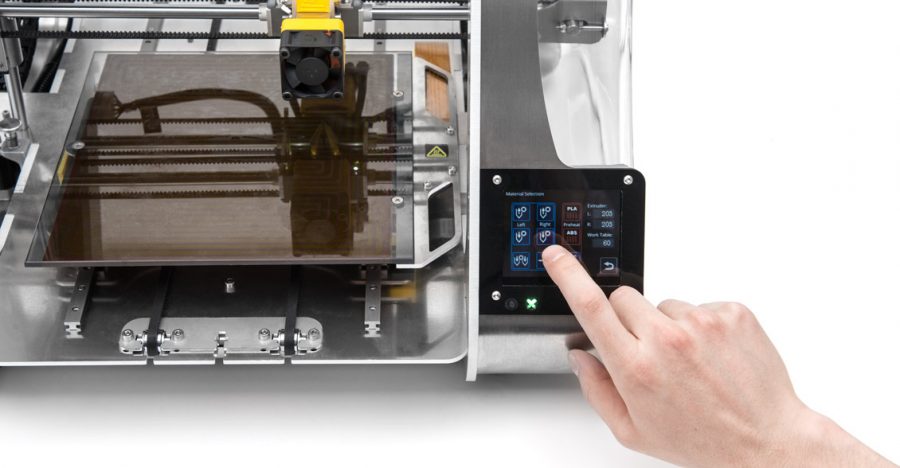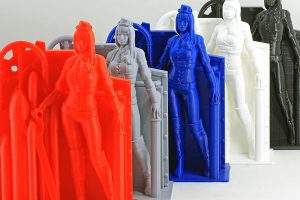Now that I’ve gotten more into 3D printing and the maker movement in general, I thought I would share a quick summary of some of the tools that have helped me make the whole process better. These products are based off a combination of best practices suggested by various third party sources and items that I’ve found useful on my own. Regardless of source, all are what I personally use at the time of this writing.
Electronic Digital Caliper
Electronic digital calipers like the Neiko 01409A Electronic Digital Caliper, allow for precise measurements of both the interior and exterior of items. This is particularly useful when trying to design or fit a 3D printed part, but obviously has uses well beyond that. While I still recommend having a good metal ruler on hand for quick measurements as well, such a product does have its limits compared to something like the Neiko, which is available in various lengths.
Electric Blower Duster
Whether it’s plastic bits or just general dust in sensitive components, this eco-friendly alternative to disposable dusters really blows (see what I did there?). I use the Metro ED500 DataVac 500-Watt 120 volt 0.75-HP Electric Blower Duster and it’s like having an indoor leaf blower. If something needs to be blown out and this doesn’t get the job done, then I seriously doubt anything will.
Hand Vacuum
Now that you blow, it’s time to suck (I just rolled my own eyes so you don’t have to). The Stanley Black & Decker FHV1200W Cordless Mini Canister Vac is a great handheld vacuum and is a good way to clean up what blowing can’t.
Stainless Steel Scraper
Stuck prints or other plastic bits on your print bed? The Titan Tools 11508 1-1/4″ Offset Stainless Steel Scraper is the ideal removal tool.
Dry Packs
If you have multiple spools of filament that you swap between on your printer, it’s a good idea to store them in a good plastic container, or, as you’ll see next, in a good vacuum bag. It’s impossible to keep all moisture out, though, so that’s why you’ll want to add one or more dry packs that you replace frequently. The 5 Gram Pack of 50 Dry&Dry Silica Gel Packets Desiccant Dehumidifiers offers an inexpensive option.
Vacuum Storage Bags
Options like the DIBAG 12 Bags Pack Set – Vacuum Storage Space Saver Bags are a great way to essentially vacuum seal your filament spools. And depending on bag size, you should also be able to fit more than one. Just be sure to toss in a dry pack or two like mentioned above and then place it all in a good plastic container for the ultimate in protection.
Knife Set
No matter what you 3D print, you’re almost certainly going to have to do some clean-up on the object. The X-Acto X5262 Double Knife Set is a great way to cut off edges and other stray bits that a regular snipper (described later) is too clumsy to handle. Just be sure you get a good cutting surface like the one suggested next.
Cutting Mat
If you’re going to work with blades, you’re going to need a good cutting surface. The Alvin Professional Self Healing Cutting Mat GREEN/BLACK (12×18) is a nice choice. I like the 12×18″ size, but it’s available in many others. If you want a protective work surface that you don’t need to (and shouldn’t) cut on, I like the KuKisheet Silicone Baking Mat 16.25 X 11.5 Inches, which has a tacky surface and lays nice and flat after being rolled up for storage.
Sandpaper
3D prints won’t beautify themselves and the Bluecell Pack of 12 Sandpaper Abrasive Dry/Wet Paper Sheets can be a big help with smoothing. For best results, work your way up from a coarse grit to a finer grit. I also like to use files like this Protian set.
Painter’s Tape
The 3M Scotch-Blue 2090 Safe-Release Crepe Paper Multi-Surfaces Painters Masking Tape is the tape of choice when taping over your print surface for better print adhesion and protection.
Pliers
The Stanley 84-114 3 Piece Basic 6-Inch Slip Joint, 6-Inch Long Nose, and 6-Inch Diagonal Plier Set has the three key tools for 3D printing. The long nose pliers are good for pulling filament, the snippers are good for cutting filament, and the slip joint pliers are good for making machine adjustments. You’ll probably want to expand this toolset in the future, but these three will go a long way when it comes to the specific needs of 3D printing. I also love the enhanced precision of the Xuron 170-II Micro-Shear Flush Cutter, which I’ve pulled for use from my soldering bag.
Wire Brushes
With the TEKTON 7068 Wire Brush Set, 9 Inch, 3-Piece Set, you can use the brass or metal brush to scrape the bottom of your printer’s hot end, and the softer nylon brush to clean off just about anything else. It goes without saying that keeping the most important part of your 3D printer clean goes a long way towards its longevity.
Conclusion
So there you have it. While I’m sure there are some tools or tricks that I’m leaving out, these are certainly the ones I’ve been using the most. Since I labeled this 2016, I’ll to remember to do one around this same time in 2017 to see if those tools and tricks have changed much. As always, I’d also love to hear about the tools that you make use of, so be sure to leave a comment here, on social media, or via the contact form. Happy making!

















 Your total news and information resource for all things Science, Technology, Engineering / Mathematics, Art, and Medicine / Health.
Your total news and information resource for all things Science, Technology, Engineering / Mathematics, Art, and Medicine / Health.
2 Comments
Leave your reply.